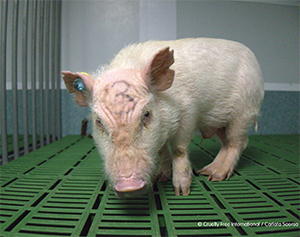Over 90,000 animals suffered in Irish labs in 2022
The Irish Anti-Vivisection Society (IAVS) condemns the grim toll of almost 93,000 animals [1] in Irish vivisection labs during 2022. The figures only count experiments that are likely to cause the animals pain, distress, suffering and lasting harm. Almost all the animals die during or are killed after the tests, even when they could be rehomed.
The figures [2] were revealed on Friday 15th December 2023 by the Health Products Regulatory Authority (HPRA).
Severe suffering for ‘Botox’ products
Once again, the majority of animals to be destroyed – an estimated 50,000 - were mice used in commercial poisoning tests for ‘Botox’-type products (Botulinum toxin), many of which are for cosmetics purposes. These tests, categorised as ‘Batch Potency Testing’ [3] have comprised the majority of Irish animal tests for over a decade now.
Botulinum toxin is one of the most powerful biological toxins known. For each test, the mice are divided into 3 or 4 groups, each receiving different strengths of the botox. Those in the highest-strength group start showing signs of poisoning within hours, with paralysis of the lower body, leading them to stagger or be unable to walk. After about a day, the paralysis starts to affect the respiratory muscles, making the mice gasp for air, start to literally go blue, and die of asphyxiation.
High dose botox tests are among the cruellest procedures that are inflicted on animals in labs, and explain why Ireland has one of the EU’s highest rates of ‘severe’ category tests at 14% of the total, or 13,212 animals in 2022.
Several years ago, companies such as Allergan developed modern cell-based tests for botox potency which normally don’t use animals. However, secrecy and commercial considerations have hindered the sharing of these new testing technologies with other botox companies and so the unnecessary suffering continues.
The IAVS accuses the HPRA and botox animal testers of routinely breaking Irish and EU law by failing to declare on their animal test applications that some of the botox is destined for cosmetic use.
Annual reduction is a silver lining
One silver lining of the 2022 statistics is that it represents a reduction in the overall numbers of animals harmed compared with 2021, with a drop of 28,619. This continues a trend over the last six years, largely driven by the gradual replacement of botox animal tests.
However, the IAVS is deeply concerned that this positive trend is more by luck than judgment. The HPRA makes clear that it does not have a pro-active strategy to reduce animal testing for good. Trends in animal testing are, according to the HPRA out of its hands and instead are largely dependent on external commercial and technological developments:
‘Decreases, for example, may arise as a result of the ongoing application of the 3Rs principles while certain extraneous developments may result in increases in the levels of animal use.’ [4]
Feeble and ‘chummy’ Inspection
One of the most disturbing revelations of the 2022 animal testing statistics is the paucity of inspections, particularly unannounced ones. The HPRA admits it only conducted 11 unannounced lab inspections [5] during the whole of 2022, less than half of all the establishments where animal testing takes place. In other words, more than half of animal testing institutions did not receive an unannounced inspection in 2022.
The IAVS comments:
‘This complacent approach to enforcement chimes with the attitude revealed by FoI requests to the HPRA, where officials have turned a blind eye to thousands of animals being left to suffer more than the legally-authorised limit. Unfortunately, the HPRA has a chummy relationship with the animal testing and vivisection industry, smoothing through their permits to hurt animals while concealing wrongdoing and breaches of animal welfare regulations. Meanwhile, it does the bare minimum in terms of pushing for the replacement of animal tests with modern human-based technologies.’
More rabbits, cats, dogs, horses, pigs, sheep and fish suffer
Other notable trends revealed by the 2022 figures include the increase in tests from 2021 on rabbits, cats, dogs, horses (and donkeys/crossbreeds), pigs, sheep, and certain fish (salmon, trout, chars and grayling). [6]
The increase in testing on pigs appears to be partly due to the controversial purpose of increasing productivity on farmed pigs. [7]
The IAVS says:
‘These tests are unlawful because they should not pass the mandatory harm-benefit assessment for animal experiments. There is no genuine ‘benefit’ to these experiments. Allowing factory farms to exploit pigs and other animals even more intensely is counter to the greater good, merely lining the pockets of dodgy businesses, while potentially increasing animal suffering and contradicting the imperative to move away from animal farming for climate breakdown reasons. What are the HPRA thinking?’
[1] 93,825 experiments on 92,939 animals – some animals are used more than once.
[2] https://www.hpra.ie/docs/default-source/default-document-library/2022-annual-statistical-report.pdf
[3] See Table 9
[4] See end of Section 5 ‘Trends’
[5] 48% of 23 Inspections in total
[6] Rabbits up from 657 to 1012; Cats up from 13 to 32; Dogs up from 83 to 32; Horses, donkeys etc up from 9 to 259; Pigs up from 727 to 2460; Sheep up from 2806 to 3544; Salmon, trout, chars and grayling down from 4986 to 1364
[7] See Table 6, ‘Animal nutrition’ and accompanying HPRA commentary.


